Archives - Page 2
-
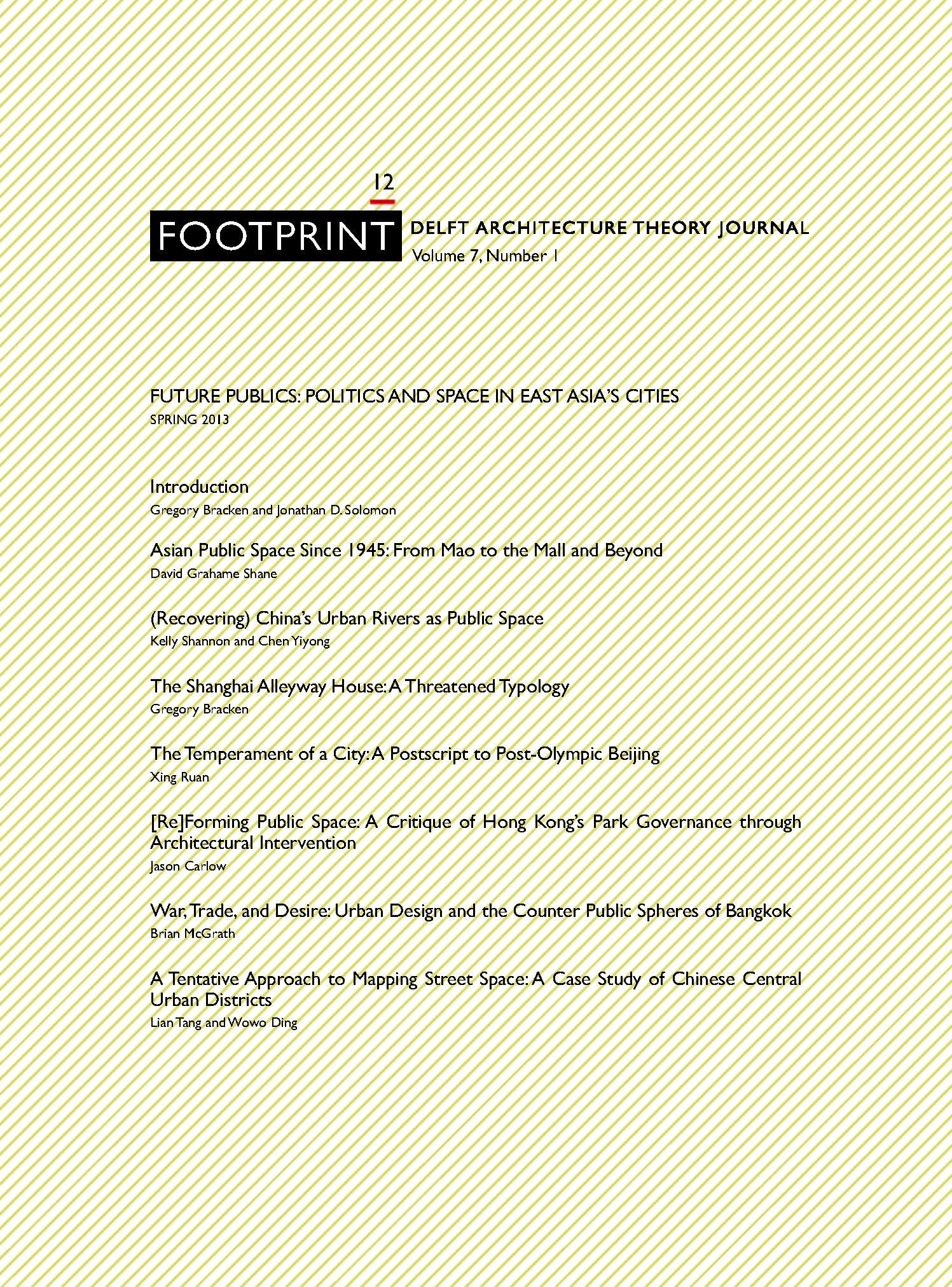
Issue # 12 | Spring 2013 | Future Publics: Politics and Space in East Asia’s Cities
This special issue of Footprint began life in Shanghai, with the third Annual Delft School of Design (DSD) and International Institute for Asian Studies (IIAS) workshop, which was organized in conjunction with the Architecture Department of Hong Kong University (HKU) and took place in their Shanghai Study Centre in April 2011. The seven papers presented here look at issues of public space in East-Asian cities, beginning with an overview since 1945 and thereafter concentrating on cities in China, such as Shanghai, Beijing, Hong Kong and Nanjing, as well as a realm that is not often considered public space: urban rivers. The issue also considers the city of Bangkok, where urban design is examined as a counter public sphere.
Issue's editors: Gregory Bracken and Jonathan D. Solomon
-
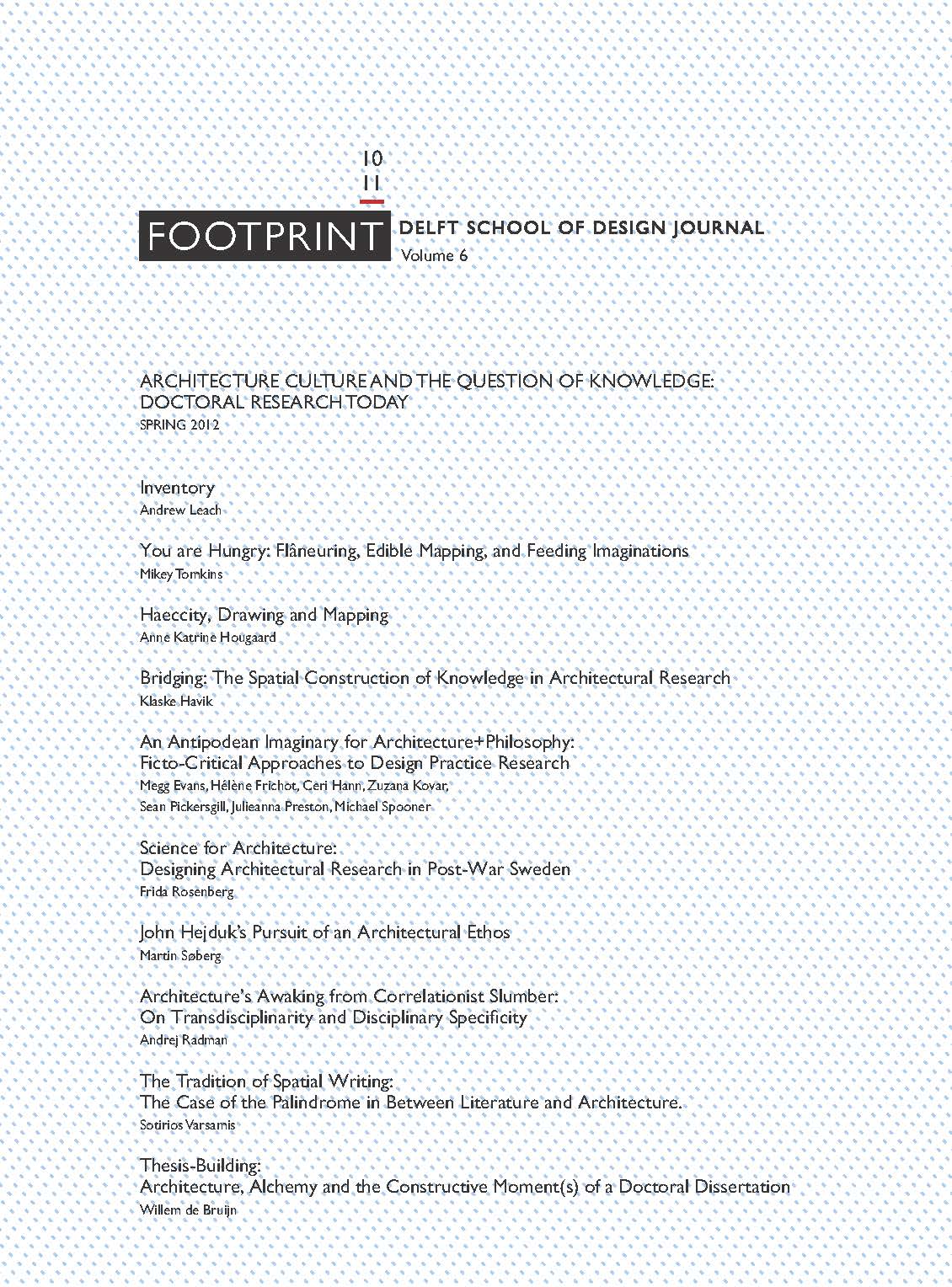
Issue # 10/11 | Spring 2012 | Architecture Culture and the Question of Knowledge: Doctoral Research Today
Over the past fifteen years most advanced education programmes within Schools of Architecture have been questioning the parameters and requirements of doctoral research both in terms of content and form. This double issue of Footprint was motivated by the question of where the field stands today. Footprint 10|11 presents nine contributions from both recently defended and developing PhD candidates from a variety of institutions. The diversity of their work, as well as the similarities found in the submissions, offers a partial view into research topics currently addressed in PhD programmes within Schools of Architecture.
In addition to the nine papers by PhD researchers, we have included a paper by Andrew Leach that we believe provides an overview of the general state of contemporary architecture research. Leach makes an appeal to refrain from making all research operational. At a time when the application of research and its economic value seem to form the primary criteria for judging value, this appeal should not be taken lightly.
Issue's editors: Deborah Hauptmann and Lara Schrijver
-

Issue # 9 | Autumn 2011 | The European Welfare State Project: Ideals, Politics, Cities and Buildings
This issue of Footprint is based on the conference session ‘The European Welfare State Project – Ideals, Politics, Cities and Buildings’ as organized by the editors at the first EAHN Conference in Guimarães, Portugal in 2010, and as elaborated in the second EAHN Conference in Brussels, Belgium in 2012 (together with Mark Swenarton). These sessions were proposed as part of the research programme ‘Changing Ideals – Shifting Realities’ at the TU Delft, which aims to further disclose, map and question the architectural culture of the second half of the twentieth century. It focuses on how the welfare state in Western Europe represents a unique time frame in which manifold shifts within the modernist discourse in architecture and planning were paired with societal changes that established new assemblages between producers, designers, governments, clients, builders and users. It is part of the editors’ assumption that the current crisis of capitalism puts the politics of redistribution back on the agenda. In re-investigating the vast legacy of the welfare state, it seems only natural to look for new models for collectivity, not to dwell in nostalgia, but indeed to find alternatives to suit the new situation. At the intersections of building practice, architectural viewpoints, national and local cultural contexts, a nuanced image of welfare state architecture emerges.
Issue's editors: Tom Avermaete and Dirk van den Heuvel
-

Issue # 8 | Spring 2011 | Defying the Avant-Garde Logic: Architecture, Populism, and Mass Culture
This issue of Footprint focuses on the post-war years and the negotiation of architecture with an ever more advanced consumer society within the context of welfare state redistributive policies. Industrial, productivist logic is mixed in this era with the biopolitics of the emerging late-capitalist spectacle, and with the shock and awe brought about by the expanding mass-media networks.
Many of the contributions to Footprint 8 highlight the need for an alternative to the options spelled out in the last decades in architecture – a ‘radical pragmaticism’ of sorts. Michael Müller, in his diagnostic essay in this volume, outlines the aporia of the current condition of artistic and architectural production, and Isabelle Doucet searches for a theory, while Fernando Quesada, Ross K. Elfline, and Nelson Mota contribute specific precedents of architectural trajectories that were never followed, ranging from Superstudio’s work to Siza’s Malagueira. Deborah Fausch returns to the debate between Denise Scott Brown and Kenneth Frampton in 1971; Isabelle Doucet reviews a book by architecture-activists BAVO, calling for a form of radical pragmatism instead of the polarity of ‘opposition’ and ‘appeasement’; and Maroš Krivý contributes a review of the exhibition Dreamlands at the Centre Pompidou. Consequently, the discussion of the 1960s avant-garde and mass culture leads to an understanding of the challenges contemporary architecture faces and to an outlining of concrete alternatives from the recent past.
Issue's editors: Dirk van den Heuvel and Tahl Kaminer
-

Issue # 7 | Autumn 2010 | Drawing Theory
The field of drawing, as practice and discourse, seems to have entered an end-condition, where the celebration of the extensive production of drawings is combined with a certain fatigue in both its understanding and reflection. Drawing, nowadays, seems to be suspended in this in-between condition of objectivity and instrumentality, as image and information, as communication and science, whereas the theoretical field generated between these polarities seems to have lost its theoretical poignancy.
The seventh issue of Footprint attempts to address this contemporary state of affairs within a disciplinary understanding of the drawn theory of architecture. The premise of raising this issue originates from the critical exploration of a field within architectural theory that in the last decades has seen a progressive ‘de-problematization’. Even though the role of drawing is nowadays still regarded as the most common act of architecture, this understanding of drawing is hardly subject to critical inquiries, and, unfortunately, mostly limited to its instrumental role within the representation of the project.
Issue's editors: Stefano Milani and Marc Schoonderbeek
-

Issue # 6 | Spring 2010 | Digitally-Driven Architecture
Similar to the way that industrial fabrication with its concepts of standardisation and serial production has influenced modernist architecture, digital fabrication influences contemporary architecture: While standardisation focused on processes of rationalisation of form, mass-customisation as a new paradigm that replaces mass production, addresses non-standard, complex designs based on non-Euclidean geometries. Furthermore, knowledge about the designed object can be incorporated at the level of its connectivity with data stemming not only from its geometry but also from its content and behaviour within an environment. Digitally-driven architecture implies, therefore, on the one hand, digitally designed and fabricated architecture, and on the other hand, it implies architecture controlled and actuated by digital means.
In this context, the sixth Footprint-issue is examining the influence of digital means on architecture as pragmatic and conceptual instruments for exploring and generating complex systems of spatial organisation as well as for constructing and actuating architecture. The focus is not only on computer-based generative systems for the development of architectural designs, but also on architecture incorporating aspects of digital sensing/actuating mechanisms that enable buildings to interact with their users and surroundings.
Issue's editors: Henriette Bier and Terry Knight
-

Issue # 5 | Autumn 2009 | Metropolitan Form
The fifth issue of Footprint investigates the question of metropolitan form. The necessity to focus on the scale of metropolitan areas is manifest as this is the dominant scale of contemporary global life. The process of urbanisation and the size of urban agglomerations have dramatically increased since the last decades. These dynamics alone demand radically changed thinking about internal spatial organisation and the form of urban regions. Yet, scholarly focus at the regional level has shifted away from spatial thinking of overall form towards issues of governance, socio-economic statistics, and global networks. While these approaches provide insight into contemporary conditions, lost in translation is the question of metropolitan form: what are the characteristics of its spatio-physical structures? What are its distinguishable elements? And what are the factors that determine the transformation of form through time? By addressing the question of metropolitan form we try to extrapolate - scale-up - the research notions and methods of ‘urban morphology’ from the ‘urban’ to the ‘regional’ scale.
Issue's editors: François Claessens and Anne Vernez Moudon
-
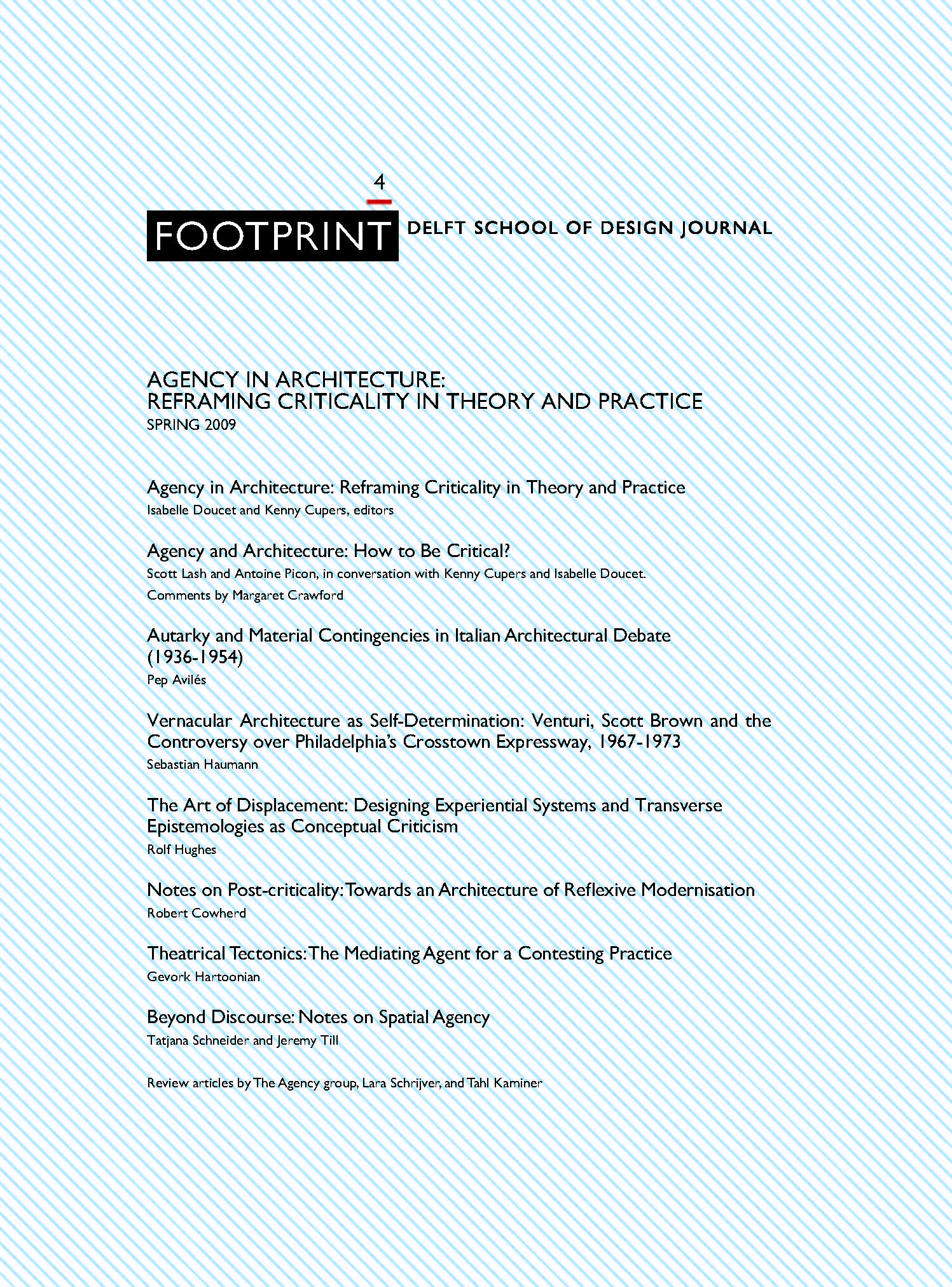
Issue # 4 | Spring 2009 | Agency in Architecture: Reframing Criticality in Theory and Practice
Whether critiquing the architect’s societal position and the role of the user, conceptualising the performative dimension of the architectural object, or considering the effects of theory for architecture at large, current debates in architecture intersect in the notion of agency. As fundamental as it is often taken for granted, this notion forms the keystone of this issue, inviting contributors to rethink architecture’s specificity, its performance, and its social and political relevance. Agency in architecture inevitably entails questioning the relation between theory and practice, and what it might mean to be critical - both inside and outside architecture - today. The main proposal is to rethink contemporary criticality in architecture, by explicating the notion of agency in three major directions: first, ‘the agency of what?’ or the question of multiplicity and relationality; second, ‘how does it work?’, a question referring to location, mode and vehicle; and third, ‘to what effect?’, bringing up the notion of intentionality.
Each of the contributions to this issue throws a new light onto one or more of these questions. In the form of an interview, Scott Lash, Antoine Picon and Margaret Crawford probe the theoretical implications of agency as a notion for architecture. Pep Avilés disentangles, in his analysis of Italian neorealist architecture, the multiplicity of historical agents shaping its discourse. Sebastian Haumann examines the intersection of aesthetic concern and political agency in Venturi and Scott Brown’s project for South Street in Philadelphia. Emphasising the pertinence of transdisciplinarity to contemporary practice, Rolf Hughes develops the notion of ‘transverse epistemologies’ that is implied by it. Inspired by contemporary sociology, Robert Cowherd proposes a ‘reflexive turn’ in architecture as a reply to the ‘post-critics’. Gevork Hartoonian reconsiders Brutalist architecture for contemporary practice, arguing that the theme of agency in architecture is tectonic in nature. Against the internalisation of architectural discourse, Tatjana Schneider and Jeremy Till posit the notion of spatial agency, as it is evoked by alternative forms of practice. Three review articles, by Lara Schrijver, 'The Agency' Group, and Tahl Kaminer, demonstrate ideological rifts in the current debate.Issue's editors: Isabelle Doucet and Kenny Cupers
-

Issue # 3 | Special issue | Architecture and Phenomenology
With this the special issue of Footprint the question of the relation of philosophy and architecture, and the significance of phenomenology for architectural practice and discourse is broadly surveyed. Individually, and overall, the articles provide reflections and arguments on topics of space, location, place, architectural practice, meaning in architecture, and on the impact of phenomenology as a philosophical form of enquiry throughout.
Stephen Read in his paper, written out of a post-phenomenological perspective associated with the work of Don Idhe, provides the basis for a new reading of Heidegger on tools and the relation of the social and the technological. A similar concern can be seen in the paper of David Kirshner, ‘Tools: Stuff: Art’. The discourse about space emerges in architecture only towards the end of the nineteenth century, and Leslie Kavanaugh’s groundbreaking study on Brentano on space provides rich context for this turn in architectural discourse towards ‘space’. Susan Herrington and Anne Bordeleau in different ways look at the problems of constituted meanings for architecture, predominantly within the French phenomenological tradition.
Michael Lazarin and Akkelies van Nes bring forward the deepening and continuing response to the work of Heidegger, through an original and new study of Norberg Schulz, and in Lazarin’s rich considerations of the contexts and sources of poetic dwelling in Japanese buildings. Randall Teal furthers the interest in the study of topology, of such concern to Hubert Dreyfus and Jeff Malpas, in the reading of the late work of Heidegger. Working as an artist and sculptor Jasper Coppes has contributed a meditative and detailed response to phenomenological ideas around place, which is of some significance for thinking about the problem of ‘domain’ in architecture. Keane and Selinger look at the work of Arakawa and Gins to demonstrate the fruitfulness of phenomenology for artistic practice and new concepts of the production of space.
Issue's editors: Brendan O’ Byrne, Patrick Healy
-
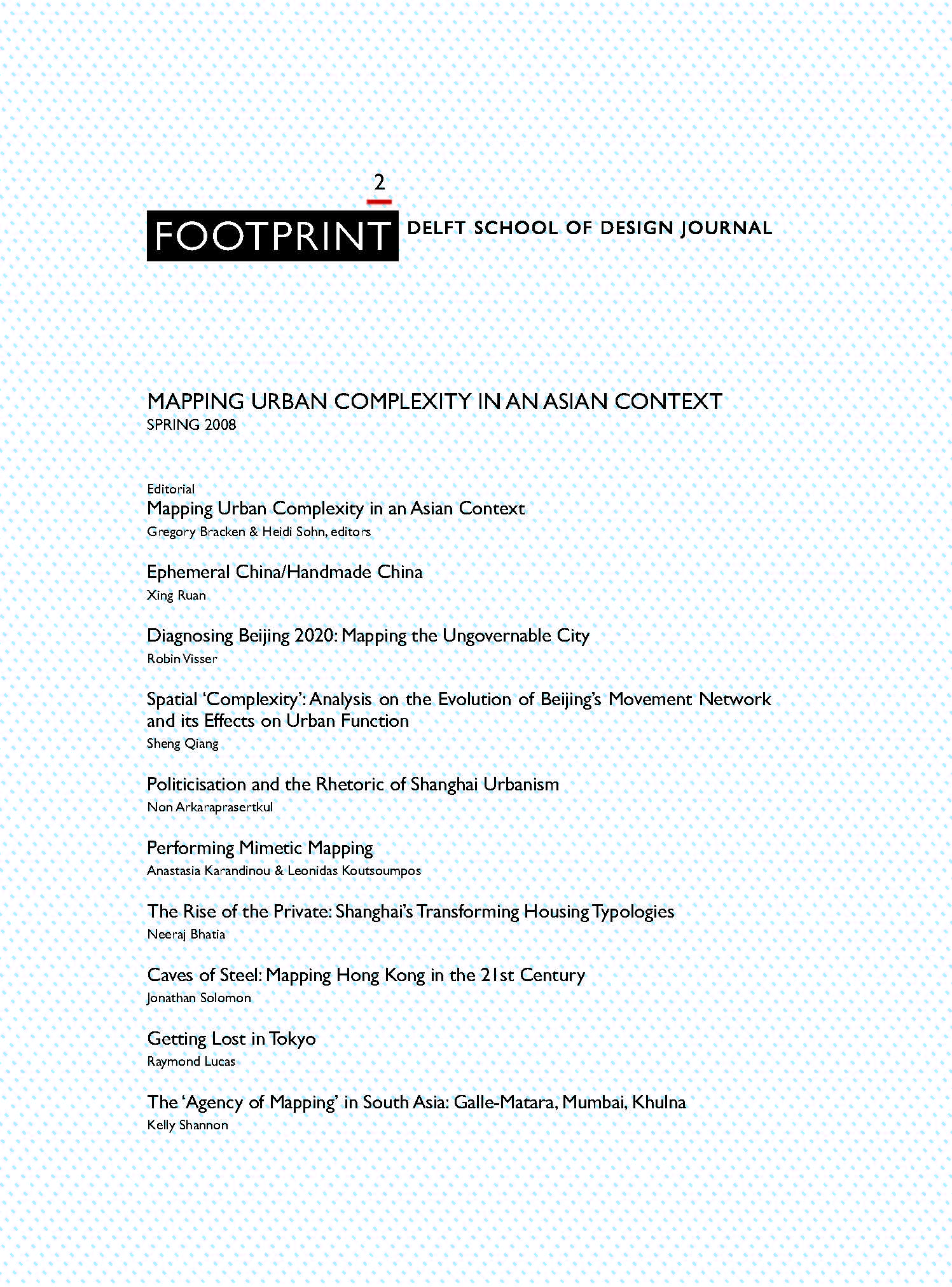
Issue # 2 | Spring 2008 | Mapping Urban Complexity in an Asian Context
The second issue of Footprint aims at reuniting two themes which are receiving a great deal of attention in recent times: Asia’s extraordinary urban growth, and the problematique of mapping highly complex urban environments. The 21st century, forecasted by many as the ‘Pacific Century’, brings to the fore the region's economic, social, political and cultural changes, wide-ranging in their manifestation and far-reaching in their consequence. All of these factors are inscribed in the urban environment. In a region where a population of one million constitutes a small settlement and mega-cities such as Tokyo and Shanghai have come to dominate the global network, sheer size is itself an important issue and not just in practical terms. Then there is the apparent chaos that is actually a delicately balanced autopoeisis in cities such as Mumbai, as well as the interesting and potentially useful city-state model of Hong Kong. These conditions and rising phenomena bring important questions on the potentials and relevance of mapping to the fore.
The nine contributors to this issue take these questions as their point of departure, and set out to explore some of the region’s most important or complex cities. Urban China is covered by Ruan’s interesting overview of this country’s frenzied economic boom, which he claims is ephemeral; Visser’s attempt to map Beijing –‘the ungovernable city’- poses timely critical questions; Qiang’s analysis of the evolution of Beijing’s movement network and the effects it has on urban function; Arkaraprasertkul’s investigation of Shanghai’s Pudong, as well as it’s older lilong; Karandinou & Koutsoumpos’ thought-provoking and beautifully rendered mapping project of Shanghai’s ‘other’ river, the Suzhou; Bhatia’s examination of Shanghai’s transforming housing typologies; Solomon’s investigation of the development of Hong Kong, particularly Victoria Harbour. Moving further east, Tokyo’s complexity is explored in Lucas’s short paper with a series of architectural drawings and movement notations exposing the act of inscription as a method of urban enquiry. And finally, Shannon’s informative and thorough mapping exercise of cities and landscapes in India, Bangladesh and Sri Lanka.
Issue's editors: Gregory Bracken and Heidi Sohn
-
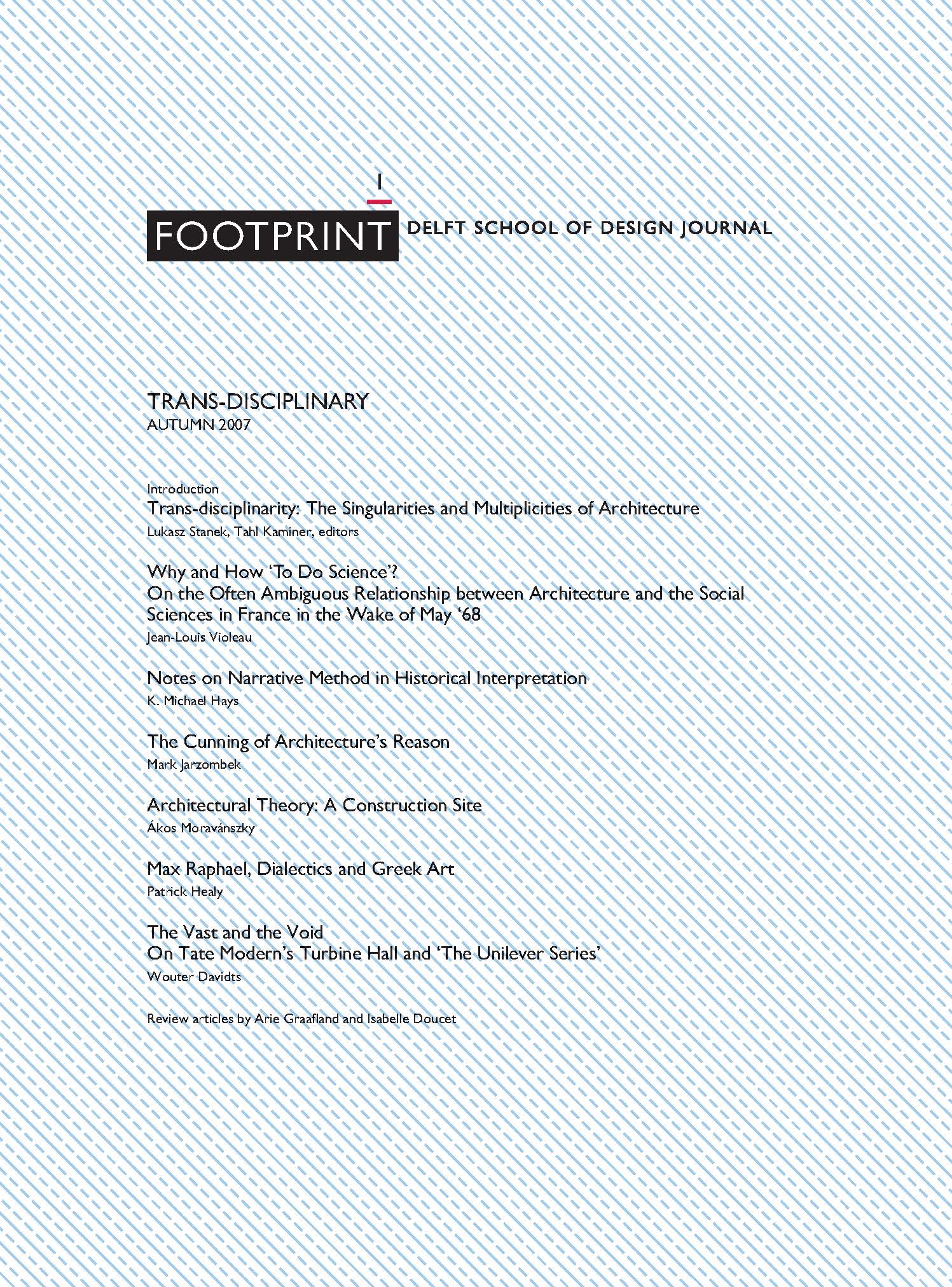
Issue # 1 | Autumn 2007 | Trans-disciplinary
This inaugural issue of Footprint aims at understanding today’s architecture culture as a negotiation between two antithetical definitions of architecture’s identity. The belief in the disciplinary singularity of architectural objects, irreducible to the conditions of their production, is confronted - in discourse and design - with the perception of architecture as an interdisciplinary mediation between multiple political, economic, social, technological and cultural factors. With the concept of trans-disciplinarity, the negotiation between these two positions is investigated here as an engine of the ‘tradition of the present’ of contemporary architecture - the discourses and designs which emerged in the 1960s and defined orientation points for today’s architectural thought and practice.
The contributions to this issue of Footprint include Wouter Davidts’ analysis of architectural design and discourse as a condition for art; Michael Hays’ examination of narrative as a form of understanding the object of architecture within the forces which it reflects and opposes; Patrick Healy’s reconstruction of Max Raphael’s project of an empirical theory of art and architecture; Mark Jarzombek’s questioning of architecture as a philosophical project; Ákos Moravánszky’s mapping of the multiple interchanges between theory, design, history and education of architecture; Jean-Louis Violeau’s account of the collaborations between architects and sociologists on architectural research in France since the late 1960s.
Issue's editors: Tahl Kaminer and Lukasz Stanek




